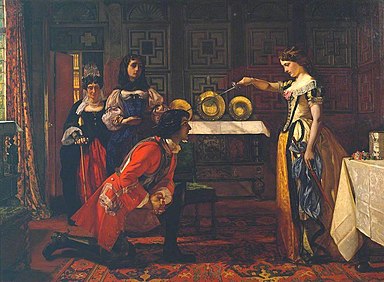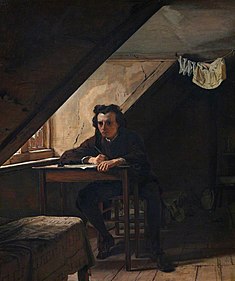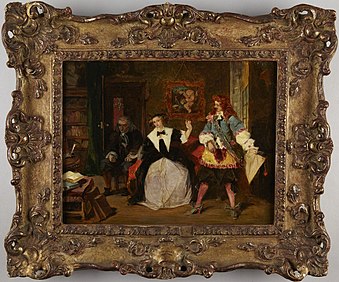Augustus Leopold Egg
Augustus Leopold Egg | |
|---|---|
 Augustus Egg by Richard Dadd (between 1838 and 1840) | |
| Born | 2 May 1816 |
| Died | 26 March 1863 (aged 46) |
| Nationality | British |
| Movement | The Clique |
| Elected | Royal Academy of Arts |
Augustus Leopold Egg
(1858), which depicts the breakup of a middle-class Victorian family.Biography
Egg was born in London to Joseph and Ann Egg, and baptised in St James's Church, Piccadilly, on 30 May 1816. He had an elder brother, George Hine Egg.
His father Joseph Egg was a wealthy gunsmith from the
Egg's early paintings were generally illustrations of literary subjects. Like other members of The Clique, he saw himself as a follower of
Style
Unlike most other members of The Clique, Egg also admired the

Egg was also an active organiser of exhibitions, being admired by fellow-artists for his dedication and fair mindedness. He was one of the organisers of the Manchester
Always in poor health, Egg spent his later years in the warmer climate of continental Europe, where he painted Travelling Companions, an ambiguous image of two near-identical young women that has sometimes been interpreted as an attempt to represent two sides of the same person. A member of the circle of friends that included Dickens and Wilkie Collins, Egg features in their surviving correspondence. He participated, as actor and costume designer, in their amateur theatricals, which were often conducted for charitable purposes as noted above. In January 1857 he took a part in Collins's play The Frozen Deep, which starred Dickens and was performed at his home, Tavistock House (Egg played John Want, the ship's cook.) The production was also acted before Queen Victoria and then performed for charity. Dickens described Egg as a "dear gentle little fellow," "always sweet-tempered, humorous, conscientious, thoroughly good, and thoroughly beloved."[5]
Egg died in Algiers on 26 March 1863.
In a 1953 radio interview, novelist Evelyn Waugh was asked "What painters do you admire most?". He answered "Augustus Egg I’d put among the highest."[6]
Gallery
Past and Present – 1858 triptych
-
No. 1 – Misfortune, 1858
-
No. 2 – Prayer, 1858
-
No. 3 – Despair, 1858
Select Paintings
-
Queen Elizabethdiscovers she is no longer young, 1848
-
The Life and Death of Buckingham: The Life of Buckingham, c. 1855
-
The Life and Death of Buckingham: The Death of Buckingham, c. 1855
-
Beatrix Knighting Esmond, 1857
-
Self Portrait as a Distressed Poet, 1858
-
Taming of the Shrew, 1860
-
Unknown woman, formerly known as Florence Nightingale
-
Madame de Maintenon and Scarron
-
The Love Letter, by 1863
Notes
- ^ "Augustus Egg – British painter".
- Oxford Dictionary of National Biography, Oxford University Press, Sept 2004
- ^ "Augustus Egg". All things Victorian. Archived from the original on 27 January 2017. Retrieved 28 September 2021.
- ^ Chisholm, Hugh, ed. (1911). . Encyclopædia Britannica. Vol. 09 (11th ed.). Cambridge University Press. p. 13; second para.
Among his principal pictures may be named:....1848, "Queen Elizabeth discovers she is no longer young"...
- ^ Ley, p. 283.
- ^ Excerpts from the text of the broadcast, on 16 November 1953, are given in the 1998 Penguin Books edition of The Ordeal of Gilbert Pinfold, pp. 135–43.
References
- Collins, Wilkie. Letters of Wilkie Collins. Edited by William Baker and William Malpas Clarke; London: Palgrave Macmillan, 1999.
- Cowling, Mary. Victorian Figurative Painting. London, Andreas Papadakis Publisher, 2001.
- Ley, J. W. T. The Dickens Circle: A Narrative of the Novelist's Friendships. New York: E. P. Dutton, 1919.
- Valentine, Helen, ed. Art in the Age of Queen Victoria: Treasures from the Royal Academy of Arts Permanent Collection. New Haven and London: Yale University Press / Royal Academy of Arts, London, 1999.












